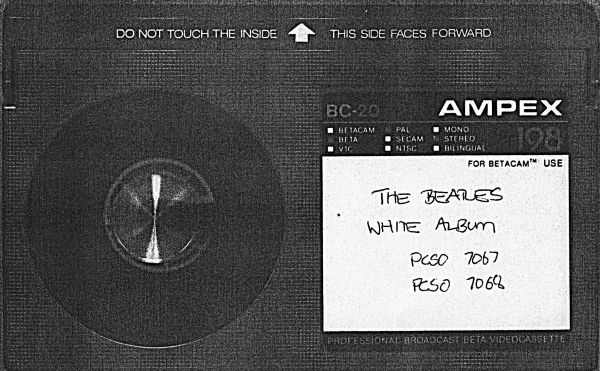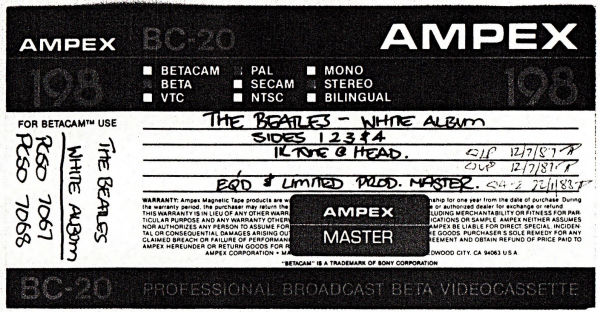While not shown on this page, EMI UK sent cassette production master tapes to EMI (Australia) in 1971 (PARLO 179/180/181/182). EMI (Australia) initially used these tapes for its cassette and 8 track cartridge releases. The track sequencing for the cassette follows the order of the cassette production master tapes, however, for the 8 track cartridge release, EMI (Australia) reversed sides 3 and 4, resulting in the album ending with 'Revolution 9' rather than 'Goodnight'. It's worth noting that the UK cassette also reversed the two sides, although the reason for doing so is unclear.
The cassette release was prepared on 30 August 1971, with the four sides running very close in time: 23:26, 23:33, 23:35 and 23:25.
Cassette copies spell 'Raccoon' as 'Raccon' and 'Sexy Sadie' as 'Sexie Sadie' on both the J-cards and cassette shells. Due to ambiguity on the Acceptance Sheet, every cassette release incorrectly carries Parlophone logos.
Sides 1 and 3 of the LP were recut from these tapes on 22 October 1982 by Don Bartley. PARLO 182 had a pen notation against 'Revolution No 1' stating "* Use 70hz bass cut". On the engineer's cutting sheet Don noted that on side 1 there are "NO SPIRALS" and on side 3 at 19:38 there is a false ending so "WATCH IT!".
At some later point the tapes were re-sequenced to the correct LP running order, with the following notes added:
- PARLO 179 - "Tape is in LP Track order" (Martha My Dear is crossed out). Record label pasted on box
- PARLO 180 - "LP Trk order". Record label pasted on box
- PARLO 181 - "This Tape Is In LP Running Order". Record label pasted on box
- PARLO 182 - "This Tape Is In LP Running Order". Record label pasted on box
In 1985, EMI (Australia) built a new three room mastering complex at its Homebush factory, incorporating a Direct Metal Mastering (DMM) suite. At that point, senior mastering engineer Allan Parsons transferred across from Studios 301 to the new complex, along with Clive Lipman (mastering manager) and Bill Ramsay (working towards retirement mastering cassettes). From then until Homebush closed in November 1990, DMM became the main vehicle by which most EMI releases - along with RCA, Polygram and other smaller labels - mastered at Homebush were produced. It became the preference for many local artists, including James Reyne, The Black Sorrows, Tim Finn/Nick Launay, Crowded House and Pseudo Echo.
Installed was a VMS-82/SAL74 DMM lathe (fitted with Maxicut) fed from an EMI TG transfer console. Connected to the desk were all the sources, including Studer A80 1/2" and 1/4" tape machines, Sony PCM-1630, Sony DAT, Sony PCM-501, and CD. It was also possible to connect a (Technics SP10) turntable.
The Sony PCM-1630 was connected digitally (SDIF-2) to a Sony digital delay unit, which output two pairs of analogue signals - preview and signal. So, the lathe was always fed an analogue input, via an analogue desk. The Studer A80s were "preview" machines - ie they had two replay heads and a system of rollers to create the necessary delayed signal for cutting. The other sources would have to be fed through the Sony digital delay.
Some of mastering engineers preferred the use of analogue sources for cutting due to the belief that DMM sounded best from an analogue source, however, digital sources were used where either analogue didn't exist or when a new production master was required, such as a different track sequence or a compilation.
Lacquer cuts (through patching in a VMS-70/VG66) were only made when there were difficulties getting supplies of copper blanks. Copper blanks were manufactured in house by an employee named Carlos from a supply of mirror finish stainless steel blanks, machined to size and copper plated in the Homebush matrix department. This particular form of amorphous copper hardened at room temperature and had to be stored in a freezer prior to use. Even so, they had to be used within a few days. Once cut, they had to be chemically treated within an hour to prevent tarnishing. The blanks could be stripped of copper and reused many times, similar to the glass master used for CDs and DVDs. This was the principal reason for splitting 301's mastering department - the DMM lathe had to be adjacent to matrix.
Despite all this, you won't see the DMM logo on any pressing made by EMI (Australia) because a) EMI (Australia) didn't pay the (Teldec) DMM licensing royalty, b) EMI (Australia) discarded some of the DMM specs (eg groove width), and c) EMI (Australia) retained the lacquer-cut disc profile so they could use the same press line.
Studios 301 was not fitted for DMM cutting, only Homebush. Without a high-powered microscope you can only tell a DMM cut by: the initials (and knowing who was working where and when); the presence of "MASTERED ON COPPER"; or, the feint inscription of "EMIDISC DMM", all in the deadwax.
Now onto this tape...


Sgt Pepper's was mastered by Warren Barnett at Festival Records and is the subject of another story. The Beatles and Yellow Submarine, however, were mastered by Allan Parsons at EMI Homebush.
Shown above is the tape (and outer box sticker) created and used for The Beatles. As you can see, it is not analogue but digital, made on a Sony beta machine. Allan Parsons had taken the original analogue cassette production master tapes, which had been in use since 1971 (and subsequently re-sequenced back to LP running order), and transferred to beta tape using a Sony PCM-701 digital converter. The Sony PCM-701 was an early consumer format, inferior to 1610/1630, and was how digital was created at EMI at that time.
While transferring, it can be assumed that Allan re-EQ'd and processed with dynamic range enhancer (there was a dbx 3BX in the rack). In essence, that makes this (and Yellow Submarine, which followed a similar process) true locally-produced digital remasters, just not sanctioned by EMI UK.
The Beatles was cut by Allan in the DMM suite on 12 July 1987, with side 4 recut by Allan on 22 January 1988. This configuration remained in use until replaced by new DMM cuts made again by Allan in November 1988, this time from the official EMI UK CDs.
The album, along with Yellow Submarine, was pressed by Festival Records (as EMI (Australia) didn't press coloured vinyl) and released on 24 August 1987. It sounded truly awful and today is nothing more than a collector's piece valued for its white vinyl.
In September 1988, Leon Zervis did something similar with The Beatles 1962-1966 and The Beatles 1967-1970, although by then EMI had the Sony PCM-1610 in its chain.
NB: The beta tape shell is actually red, not black as the scan suggests.